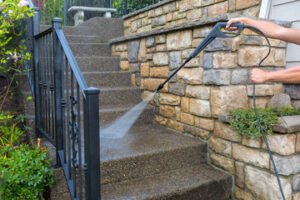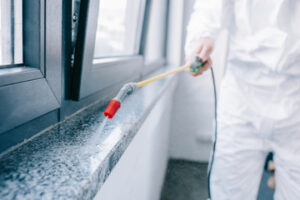Unlike scrubbing, the forceful water stream from a pressure washer penetrates crevices to lift and loosen dirt, mildew, moss and other debris. It also has kinetic energy, which helps break the bond between the surface and contaminants for easy removal.

It’s important to select the right nozzle for your project—one with a smaller degree spray pattern is safer for delicate surfaces like painted brick or stucco. Also, don’t get too close with the nozzle to avoid damage. Visit https://newcleanpressurewashing.com/ to learn more.
Pressure washing is an effective way to clean a variety of outdoor surfaces. It can remove dirt, mildew and mold, as well as some types of stains. It is also suitable for cleaning concrete driveways, sidewalks, patios, decks and more. It can be combined with detergents and cleaning solutions to enhance the effectiveness of the cleaning process. These chemical compounds can break down grease and oil, allowing the water to penetrate more deeply into porous surfaces and dislodge stubborn dirt.
Mildew and mold are fungal growths that can damage your home’s exterior surface. In addition, they can pose health risks and aggravate allergies and respiratory issues. By removing these substances, pressure washing helps to create a safer and healthier living environment.
Moreover, regular pressure washing can prevent the formation of these substances and extend the lifespan of your exterior surfaces. However, it is important to note that the forceful stream of water from a pressure washer can also cause damage if used incorrectly. For this reason, it is important to hire a professional who is trained to handle and operate a pressure washer safely.
There are several types of pressure washers on the market, each with its own advantages and disadvantages. For example, some are gas-powered and offer greater power than electric models. However, gas-powered units tend to be more expensive than electric ones.
The type of pressure washer you choose will depend on the type of work you need to do. For example, a gas-powered unit is better suited for large jobs that require more power than an electric model.
Choosing the right nozzle is also essential for safe and effective pressure washing. The nozzle size and pressure will determine how much water is released and whether it can be targeted at specific areas of the surface being cleaned. It is also important to protect yourself from the force of the water spray by wearing protective clothing and using a face mask.
Space Clean uses a high-pressure washer to tackle a range of tasks, including cleaning asphalt, vinyl siding, Trex and wood decks, concrete driveways, brick walkways and patios, and more. We also use a bleach mixture to kill off any mold or mildew that is growing on the exterior of your property.
Removes Stains
The mechanical force of pressure washing can remove dirt and grime, but adding specialized pressure washer detergents to the mix turns this tool into a powerful stain remover. Specialized cleaning solutions can lift stains from wood and vinyl siding, aluminum and other metals, driveways and walkways, decks, paving stones, roofs and even concrete structures. Often, especially with very tough stains, the first step in the cleaning process is to pretreat the area with a soapy mixture and a brush before applying the pressure wash.
Oil and grease stains are among the most difficult to remove from exterior surfaces, but they can usually be washed away with a good degreaser and a power washer that has a 1700 psi or higher setting. For really stubborn stains, the use of tri-sodium phosphate (TSP) may be necessary.
Professionals know exactly how to handle a pressure washer and will carefully evaluate the surface to be cleaned. They understand the proper psi for various surfaces and will properly select the nozzle to prevent damage. They will also know the best cleaning products and how to use them, as well as how to properly rotate and maneuver the nozzle to avoid damaging the surrounding structure or vegetation.
Whether you need to remove mold and mildew, moss, mildew, dirt or other materials, this is the best way to get them clean without harming the surface you’re trying to preserve. A professional will use the right nozzles to avoid any damage, and they’ll always test their spray on an inconspicuous spot before blasting anything away.
While a lot of people take on DIY pressure washing tasks, it is important to leave this kind of work to the professionals. Unless you have the right equipment, experience and knowledge of what it takes to safely and effectively operate a pressure washer, it is very easy to damage your home or business with too much water pressure and harsh cleaning chemicals. It is also very important to understand the delicate balance of mechanical force (PSI and GPM), chemical action (detergents) and thermal dynamics (heat). A trained professional will ensure that all these elements are in harmony when cleaning your property, keeping it safe, effective and environmentally responsible.
Prevents Damage
Pressure washing removes pollutants like dirt, mildew, bird droppings and graffiti, which can cause damage to surfaces if left unattended. Cleaning these substances regularly with a professional grade cleaner and a suitable pressure level can prevent them from damaging the surface of your building or outdoor furniture and can also help protect you and your employees from diseases that are carried by these contaminants.
Regular cleaning can also help your company save money on repairs caused by the neglect and buildup of grime. Adding pressure washing to your routine maintenance can identify problems before they become major issues that require costly fixes and can keep your property looking newer for longer.
The high-pressure water used in pressure washing can damage some surfaces if it is not properly controlled. A good professional will know the correct psi to use for each surface type and can adjust the water rotation accordingly. They can also ensure that the nozzle is kept a safe distance from any surface to prevent damage.
While hard and porous surfaces like concrete driveways, sidewalks and roofs are good candidates for high-pressure washing, softer materials such as wood, vinyl siding and shingles require a gentler approach. These surfaces can be damaged by excessive psi, especially if they are older or fragile.
A pressure washing professional will be able to evaluate your needs and select the right tools for the job. They can also advise you on the right chemicals and pressure levels to use for each surface type. They can even clean delicate vegetation with a low-pressure water spray or “soft wash” to prevent damage.
Using a hose to clean a house or office exterior can be time-consuming and inefficient, but with an industrial grade washer, it only takes minutes to blast away dirt, grime, mildew and other contaminants. The equipment is safe for the environment and can be used in areas where water may run off, such as landscaping or parking garages. It is also a better option for surfaces that cannot be easily cleaned with traditional cleaning methods, such as the sides of stairs.
Saves Money
Pressure washing uses a water pump to accelerate the flow of water, creating a high-pressure stream that can clean surfaces such as driveways, decks, and patios. It can even wash away moss, mildew, and algae from exterior walls, roofs, gutters, and fences. The process is less labor intensive than manually cleaning surfaces, saving valuable time and effort. A professional pressure washer can also use specialized detergents to create longer-lasting results that are gentle on surfaces and surrounding plants.
It Can Protect Health and Safety
Dirt, mildew, mold, and other contaminants that accumulate on surfaces can pose serious health risks if inhaled. Pressure washing regularly removes these substances from outdoor spaces, protecting the health and safety of those who live in or visit a property. It also helps to prevent vermin from gaining access to buildings, as they are less likely to be drawn to areas where disease-causing bacteria and other harmful materials have accumulated.
It Can Add Value to a Property
A property’s curb appeal is a big factor in its overall value, and pressure washing is an inexpensive way to improve the appearance of a home or business. It can make an old, run-down building look brand new, increasing its value and helping to sell it quickly. It can also help to extend the life of furniture, equipment, paint, and other materials by preventing deterioration and staving off damage.
It Can Reduce Energy Costs
Over time, exterior surfaces can build up layers of dirt and debris that obstruct the flow of natural sunlight into interior living spaces. Pressure washing can remove these layers, allowing sunlight to penetrate more deeply into homes and businesses and cutting down on heating and cooling costs.
A thorough and regular pressure wash can drastically cut down on the need for costly repairs or replacements. It can extend the life of materials such as wood, vinyl, and shingle roofs. It can also help to save on maintenance costs by preventing the growth of mold, mildew, and algae. And, by removing paint and other surface coatings that are deteriorating, it can reduce the need for repainting and resealing.

